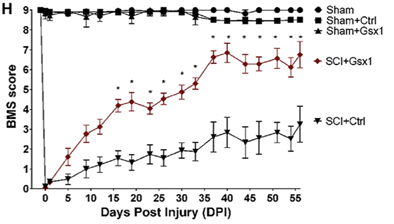
Gsx1 treatment promotes recovery of locomotion function in injured mice.
Invention Summary:
Spinal cord injury (SCI) can lead to permanent disruption of nervous system function. There is no effective treatment for promoting recovery of motor function after SCI currently available on the market. Previous research on SCI treatment focused on cell transplantation, glial scar repression, or promoting axon regrowth. Although these efforts have laid important groundwork in the field, their translation into clinical practice has been limited due to the lack of significant functional recovery.
Rutgers researchers have identified a novel method to treat SCI via gene therapy. The team first discovered the important roles of a transcription factor “Gsx1” in functional recovery after SCI. They found that Gsx1 has the ability to promote neurogenesis and axon regeneration and inhibit astrogliosis in injured spinal cord. Through in vivo studies in mice, they demonstrate that introducing Gsx1 through a lentivirus or AAV improves locomotion in injured mice.
Advantages:
- In vivo data demonstrating safety and efficacy of proposed treatment
- This method overcame multiple obstacles (e.g., immunorejection, long-term survival, and functional integration) of cell transplantation approach
Market Applications:
- Spinal cord injury treatments
- Gene therapy
Intellectual Property & Development Status:
Provisional patent application filed, patent pending. Available for licensing and/or research collaboration. Please contact marketingbd@research.rutgers.edu.
Publications:
- Patel M, et al., (2021). Molecular Therapy. 2021. doi: 10.1016/j.ymthe.2021.04.027.
- Patel M, et al., (2021). Experimental Neurology. 2021 Nov;345:113826. doi: 10.1016/j.expneurol.2021.113826.